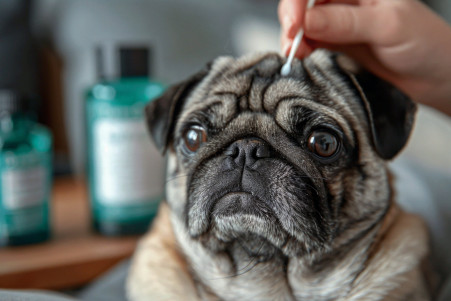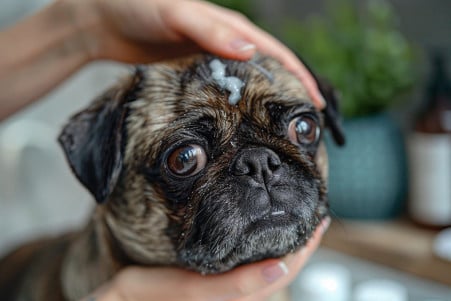Can I Put Aquaphor on My Dog? Safe Skincare for Your Pet
11 February 2024 • Updated 10 February 2024

If you have a dog, you probably have a tube of Aquaphor in your medicine cabinet. But can you use it on your dog? The good news is that Aquaphor is safe for dogs and can help soothe dry noses, paw pads, and elbows. Just make sure to use a small amount and only apply it to the affected areas.
That said, you do need to be careful because large ingestions can lead to stomach upset, so make sure to talk to your vet if your dog’s skin issues aren’t going away.
This article will take a closer look at a number of animal studies, expert opinions, and other scholarly articles to help you better understand if and how Aquaphor can be used on dogs.
We’ll cover everything from the ingredients and their impact on dogs to how to use it and when you might want to consider other options. With this information, you’ll have everything you need to know to safely and effectively use Aquaphor to care for your dog’s skin.
Can I put Aquaphor on my dog?
What the Ingredients in Aquaphor Do to Dogs
Aquaphor, an emollient that is commonly used to treat dry skin, contains ingredients such as lanolin. According to ScienceDirect, lanolin is a complex mixture of lipids, which includes fatty acids, alcohols, sterols, and other compounds. These ingredients are used to help moisturize and protect the skin when applied topically.
While these ingredients are safe for dogs when used externally, the safety of Aquaphor changes when it comes to the possibility of dogs ingesting it. Dogs can be allergic to certain ingredients in topical treatments, and ingesting large amounts can lead to other health issues.
A case study published in PMC shows the dangers of dogs ingesting topical products; a dog suffered from severe toxicosis after ingesting a cream that contained fluorouracil. While Aquaphor does not contain fluorouracil, this case shows how dangerous it can be for dogs to ingest dermatological products.
Dogs may have trouble metabolizing some of the components in Aquaphor that have a high molecular mass, such as those in lanolin, if they ingest it. This is an important distinction to make because while a product may be safe when used topically, it can be dangerous when ingested. Because of this, it may be helpful for canine health to look into alternative ingredients that are easier for dogs to digest.
Veterinarian Advice on Aquaphor for Dogs
Veterinarians often suggest using Aquaphor for dogs to help with minor skin issues. Real Simple magazine suggests that pet parents apply a light layer of Aquaphor to dry noses and other dry skin areas twice a day.
This can help with dry skin, superficial wound healing, and protection from the elements. Betterpet also notes that Aquaphor can be used to treat crusty noses and paw pad hyperkeratosis, as long as the skin infection is treated first.
While Aquaphor is safe for dogs’ skin, professionals warn against letting dogs eat it because it can cause diarrhea and, in rare cases, aspiration pneumonia as noted by Betterpet. However, Aquaphor isn’t recommended for all skin issues; for example, veterinarians don’t recommend using it on hot spots because it can lock in moisture and make the problem worse. In these cases, a vet may recommend a topical antibiotic spray or cream.
Veterinarians advise pet parents to use Aquaphor responsibly and to always check with a vet if they’re unsure about their dog’s health or if they want to try a new treatment. Because of the limitations of Aquaphor, pet parents may need to look into other treatments, such as Natural Dog Company’s Paw Soother, which Betterpet says is a great option because it uses organic ingredients that are safe for dogs.
How to Use Aquaphor on Your Dog’s Skin
To make sure that Aquaphor helps your dog’s skin heal without causing any other problems, it’s important to apply it properly. First, clean the affected area with a gentle, dog-safe cleanser. Then, apply a small amount of Aquaphor—there’s no need to cake it on, a thin layer will do. Finally, gently massage the ointment into the skin to help it absorb, notes Glencoe Animal Hospital.
It’s important to make sure your dog doesn’t lick the area where you’ve applied Aquaphor, as this can lead to an upset stomach. You can use dog booties or an Elizabethan collar to help with this. If your dog is still licking the ointment, VCA Animal Hospitals recommends using an Elizabethan collar or a recovery suit to ensure that your dog doesn’t ingest it.
After you’ve applied Aquaphor, make sure to watch your dog for any signs of a bad reaction. If the area you’ve treated gets worse or your dog seems uncomfortable, call your vet right away. Finally, make sure to keep Aquaphor in a safe place where your dog can’t get to it so that it doesn’t get into it accidentally, but you can still use it when you need to.
What to Do If Your Dog Eats Aquaphor
While it’s safe to use Aquaphor on your dog’s skin, if your pet ingests it, it can cause some health issues. If your dog eats a large amount of Aquaphor, it can cause gastrointestinal upset, which can lead to vomiting or diarrhea.
This is because non-ionic and anionic detergents, which are found in many personal care products, can cause symptoms like drooling and gastrointestinal upset if ingested, according to PetMD, which is consistent with the potential side effects of a dog eating Aquaphor.
While there are no specific case reports of dogs eating Aquaphor, the FDA warns pet owners about the dangers of dogs ingesting human drugs and personal care products, so it’s important to make sure these items are out of reach.
If your dog does eat Aquaphor, make sure to get them to a vet right away to ensure that any toxic effects are treated. In these situations, dog owners should contact their veterinarian or an animal poison control center immediately.
To avoid any potential problems, make sure to keep Aquaphor and similar products in a safe place. The FDA says that pet owners should store products in a way that limits pets’ exposure to potentially dangerous substances and keep drugs and personal care products in a place where pets can’t get to them.
When you’re thinking about whether or not to use Aquaphor on your dog’s skin, this is something to consider in addition to the potential risks and benefits of the product.
Evaluating Aquaphor’s Impact on Canine Skin Health
While Aquaphor can help with dryness and minor skin irritations in dogs, its broader impact on canine skin health needs to be taken into account.
As noted by DVM360, research on treatments for atopic dermatitis in dogs has focused on topical treatments that repair the skin barrier, often in comparison to topical steroids. While Aquaphor has not been studied in these trials, its emollient effects may have similar impacts on moisturizing and protecting the skin barrier.
That said, Aquaphor’s impact is limited and may not be the best option for all skin problems. For example, the International Committee on Allergic Diseases of Animals (ICADA) guidelines for atopic dermatitis recommend a multi-pronged approach, and research in BMC Veterinary Research and on PMC has found that treatments that address the allergic response, such as essential fatty acids or antimicrobial treatments, may be more helpful.
In conclusion, Aquaphor can be a helpful part of a dog’s skin care routine for mild dryness, but it’s not a cure-all. Other treatments that are in line with veterinary advice may be more helpful for more serious or complicated skin issues. Pet parents should consider the range of treatments available, including those made specifically for dogs, to make sure their pets are as comfortable and healthy as possible.
Conclusion: Can You Use Aquaphor on Your Dog’s Skin?
To sum up, when used topically, Aquaphor can be a safe and effective way to treat minor skin problems in dogs. As we’ve discussed, it can help hydrate dry noses, paw pads, and elbows and also act as a protective barrier for sensitive skin.
That said, it’s important to be careful when using it to avoid the risk of dogs ingesting it, which is why responsible pet ownership is so important. Proper storage is also important to avoid the gastrointestinal issues that can come from accidental ingestion.
It’s also important to stress the importance of consulting with a vet. Not only should you see a vet if your dog has a skin issue that doesn’t go away, but you should also consult with a vet before starting any new skin care routine for your dog, including using Aquaphor.
Vets can help you come up with a plan that’s tailored to your dog and can help you sort through the many treatment options that are out there to make sure you’re doing what’s best for your dog’s skin health.
As a pet owner, it’s important to weigh the pros and cons of using products like Aquaphor. However, if you make sure to do your research and follow your vet’s advice, you can use Aquaphor in a way that’s safe and beneficial for your dog’s skin, helping them feel better and be more comfortable.


